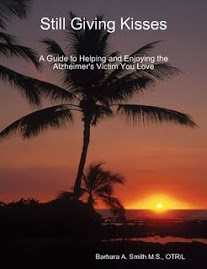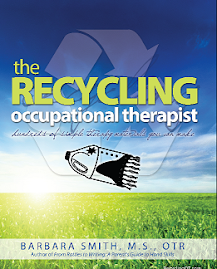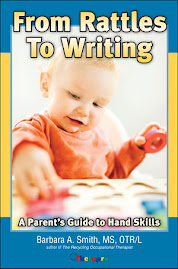Here Comes the Sailing Bride
My sister-in-law started her marriage off with a vestibular sensation. check it out!
Thursday, August 27, 2009
Monday, August 24, 2009
Horse at Olcott Amusement Park
Tomorrow we climb a mountain in New Hampshire and will stay at the Mitsvah hut. This is my first time climbing and then staying in a hut on the mountain.
Barbara Smith, M.S., OTR/L author of, The Recycling Occupational Therapist
HorseOT.com
Wednesday, August 19, 2009
ROOBOS
A big part of hippotherapy is helping children who have gravitational insecurity or fear of being off the ground. By positioning the basket off to the side and downward this little girl has to Reach Out Of her Base Of Support or ROOBOS. She has made huge gains since riding and can now turn from forwards to sideways to backwards and around forwards again with just some verbal prompts.
Connecting these pop-it-beads is always an interesting motor planning activity since so many kids attempt to connect the bead while stabilizing from the bottom of the chain rather than grasping the bead that is being connected. Some kids can attach them after having their hands repositioned, but others do not yet have the hand strength. I think this is overall a great activity to work on strenght, motor planning, sequencing, bilateral hand use and balance.
Barbara Smith, M.S., OTR/L author of, The Recycling Occupational Therapist
HorseOT.com
Monday, August 17, 2009
Saving Ben: A Father's Story of Autism
I wrote a bit in the previous entry about the book I was reading called Saving Ben: A Father's Story of Autism. Dan Burns the author sent this photo of Ben doing some type of equine therapy (not sure exactly what type) but this is a child (actually now an adult) who enjoys sensory stimulation whether riding a horse, hiking or cycling.
Occupational therapists will find the description of the home based sensory integration he had when 3 years old pretty interesting. Rather than talk more here- please visit my Amazon book review at:
Amazon Book Review
I will also be having a review on the same book written with a focus on occupational therapy issues in the Advance for Occupational Therapists magazine. Obviously, I loved this book. It was well written and has a lot of important information for those of us in the field and with family members affected by autism.
Barbara
Oh, here is Dan Burns' web site: Saving Ben Book
Barbara Smith, M.S., OTR/L author of, The Recycling Occupational Therapist
HorseOT.com
Friday, August 14, 2009
Saving Ben: A Father's Story of Autism
Dan E. Burns, the author of Saving Ben: A Father's Story of Autism sent me a copy of his new book so that I could write a review. I am so glad because even though there are plenty of memoirs on the autism parenting experience, he is a really talented writer and I always find that each memoir has a different perspective to offer.
I am only halfway through the book, but in this case the boy has severe developmental delays and at five years of age the parents suffer through- screaming, lack of toilet training, stripping and an overall unwillingness to cooperate doing anything for himself. Now the father has discovered that behavior modification can make a big difference in his search for a "cure". I don't believe that autism can be cured but I do believe that the person can be helped to lead a happy and productive life. Even Temple Grandin who is obviously successful, is not "cured".
However, a few thoughts- I come across parents during my hippotherapy work who have syrupy sweet voices even while saying "no" as the child throws a toy and wonders why the child has these behaviors. I try to role model being firm. My voice gets angry when the child tries to pull my glasses off or throws my activity on the ground and then I make them do the activity (hand over hand) one more time. After that I try to find something they really enjoy, (like popping bubbles while we walk), can do successfully and follow up with a rewarding trot.
I always want the kids to get a lot of sensory stimulation with trotting, weaving and going up and down hills no matter what, so I often start out the session with these and toward the end of the session do something less desirable (such as lacing a board or closing buttons) and give an additional trot afterwards. I also like to have the horse walk, stop for the child to do a brief step in an activity (such as put a ring on a stack) and then walk again (movement reinforcement again). All that stop and go provides its own wonderful sensory input.
These are just a few thoughts spurred on by this book and I will write more when I finish reading it. The best thing about hippotherapy and the kids with autism is that I have all these great sensory reinforcers at my fingertips and they can't run away from me.
Barbara
Barbara Smith, M.S., OTR/L author of, The Recycling Occupational Therapist
HorseOT.com
1 comments:
In reference to the video about the study at Washington University- Karma Anais said...
-
Too bad they called it horse therapy and not occuaptional or physical therapy using equine movement or OT or PT using hippotherapy as a treatment strategy. The continue to confuse riding for people with disabilities with medical treatment that incorporates equine movement.
Certainly Tim's work is phenomenal and he's an OT! Go OT! - August 13, 2009 3:49 PM

Post a Comment
Yes, by calling it "horse therapy" it makes it sound like they are treating the horse rather than providing OT. PT or SL therapy. They used the term "hippotherapy" at the beginning and at the end of the piece and "equine therapy" a few times during it, as well as using the term "horse therapy" several times. They probably thought that they were making it easier to follow by using these terms but unfortunately, I think that made it more confusing for people unfamiliar with equine assisted therapies to understand the differences.Barbara
Horseot.com
Wednesday, August 12, 2009
Working on Snaps
One boy with autism thought that my ring stack with vibrating toy inside was hilarious and laughed throughout the activity. He needed less cuing than usual to continue the task by picking up rings that I placed in front of him (while facing backwards). I put the rings inside the cat bed shown below and we were able to manage this while the horse was walking. This was rewarding since the child I saw before him fell asleep one minute after being positioned on the horse and she ended up leaving after a ten minute trail walk.
Barbara Smith, M.S., OTR/L author of, The Recycling Occupational Therapist
HorseOT.com
Thursday, August 6, 2009
Wednesday, August 5, 2009
Using Cat bed for adaptations
This child is on the horse facing backwards. I dumped the puzzle pieces into the bed so they wouldn't get lost and used the bed to support the puzzle. I also used the bed as a work surface (over the horse croup) while a child connected button squares.
But trying to use the bed to hold tactile balls was a disaster, since the balls easily fell out. I am going to sew some type of bag inside to hold objects in place. The kids love the soft material. When I fold the round bed it works well simply as a pillow to bear weight on while the child faces backwards or forwards.
On another note, a child who is tactile defensive was willing to put all the tactile balls back inside a bag (shown below). Another child with gravitational security was willing to reach high up the mane to pull off pins.
Barbara Smith, M.S., OTR/L author of, The Recycling Occupational Therapist
HorseOT.com
Monday, August 3, 2009
Using Tactile Balls for insertion Task
I knit this small bag and clipped it to the tack today. I was able to design the bag so that the opening was just big enough for children to insert balls, but small enough to keep them from easily falling out.
Then I collected the many squeeze/stress/tactile balls bought over the years.
It seems that children either love or hate these balls. They definitely are fun to use in placement activities when the child is not tactile defensive. Some kids actually cried when I put them in their hands.
Other children enjoyed inserting them into the bag as part of a squat and stand sequence or rotating to reach the bag while facing backwards.
On another note, a little guy who is usually very happy and cooperative was frightened to the point where I took him off the horse, because the flies were making the horse shake so much. I just hope that he doesn't have a bad association now when he comes to the farm.
Barbara Smith, M.S., OTR/L author of, The Recycling Occupational Therapist
HorseOT.com
Subscribe to:
Posts (Atom)







